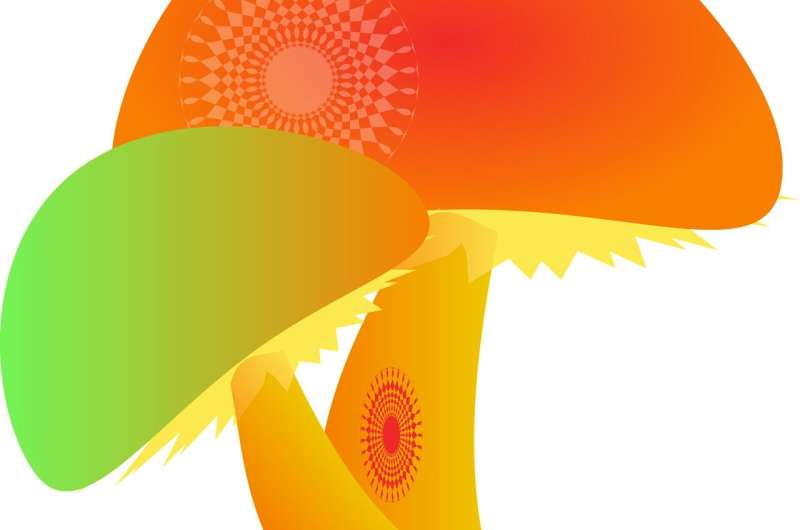New study estimates over 5.5 million US adults use hallucinogens

Hallucinogen use has increased since 2015, overall and particularly among adults 26 and older, while use decreased in adolescents aged 12–17 years according to a new study by Columbia University Mailman School of Public Health and Columbia University Irving Medical Center. Estimates of over 5.5 million people in the U.S. used hallucinogens in the past year in 2019, which represents an increase from 1.7% of the population ages 12 years and over in 2002 to 2.2% in 2019.
LSD use between 2002 and 2019 increased overall and in all age groups with the past 12-month rate increasing from 0.9% in 2002 to 4% in 2019 for those 18-25 years of age. Conversely, PCP use between 2002 and 2019 decreased, as did the drug Ecstasy since 2015. The study is the first to provide formal statistical analyses of trends in prevalence of hallucinogen use overall and by age groups during the last two decades.
The findings are published online in the journal Addiction.
To assess trends in hallucinogen use in the U.S. general population, the researchers analyzed data from the National Survey on Drug Use and Health (NSDUH) from 2002 to 2019 for participants 12 years of age and older.
The use of hallucinogens—a broad category of psychoactive substances, including "classic" psychedelics such as LSD—are mostly designated as Schedule I drugs in the U. S., and may entail risk for adverse consequences including anxious reactions, confusion, acute delusional states and a prolonged sense of fear and dread. LSD and Ecstasy and several other hallucinogens are associated with an increased risk of autonomic, endocrine, cardiovascular and neurological adverse effects. including elevated blood pressure, heart rate and loss of appetite, tremors and seizures. PCP is considered to be one of the most dangerous hallucinogens, and known to cause adverse effects similar to LSD and ecstasy, but unlike those drugs, PCP can lead to hostile and violent behaviors that may result in severe trauma.
"While new findings suggesting benefits from use of certain hallucinogens among a range of cognitive areas are being published at a rapid rate, there are still gaps in knowledge concerning safe hallucinogen use, and evidence for potential adverse effects even with professionally supervised use that warrant attention." said Ofir Livne, MD, MPH, postdoctoral fellow in the Department of Epidemiology at Columbia Mailman School, and first author.
From 2002 to 2019, the prevalence of 12-month LSD use increased significantly overall and among respondents aged 12–17 years. However, the prevalence of great risk for regular LSD use decreased significantly overall for the years 2002–14, and among all age groups.
"Our finding of an upward trend in 12-month LSD use, overall and by age, matches our finding of a downward trend in perception of LSD as risky," said Deborah Hasin, Ph.D., professor of epidemiology (in psychiatry) at the Columbia University Irving Medical Center, and senior author. "Factors such as changes in risk perception, in the specific types of drugs available and in expectations of beneficial effects of 'microdosing' may all have led to increased use of certain hallucinogens in recent years."
According to author Livne, "Given the recent media coverage showing that an increasing number of adults may be reporting positive effects of 'microdosing' and expecting therapeutic benefits of hallucinogens without negative effects, our findings merit a comprehensive examination of time trends and motives for hallucinogen frequency and quantity of use."
"In light of popular media reports of a forthcoming 'psychedelic revolution' with commercialization and marketing that may further reduce public perception of any risk, researchers, clinicians and policymakers should increase their attention to the rising rates of unsupervised hallucinogen use among the general public," observes Hasin. "Our results highlight such use as a growing public health concern and suggest that the increasing risk of potentially unsupervised hallucinogen use warrants preventive strategies."
Co-authors are Dvora Shmulewitz, Department of Psychiatry, Columbia University Irving Medical Center, and Claire Walsh, New York State Psychiatric Institute.
More information: Ofir Livne et al, Adolescent and adult time trends in US hallucinogen use, 2002–19: any use, and use of ecstasy, LSD and PCP, Addiction (2022). DOI: 10.1111/add.15987


















